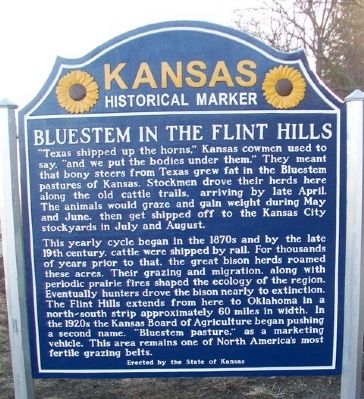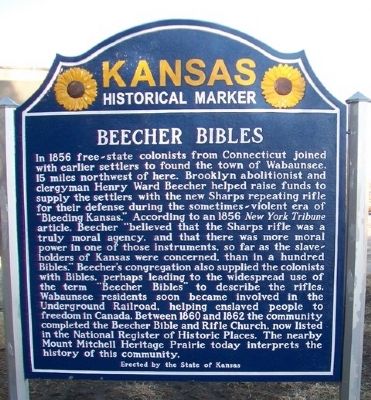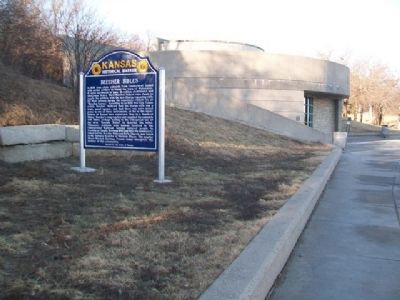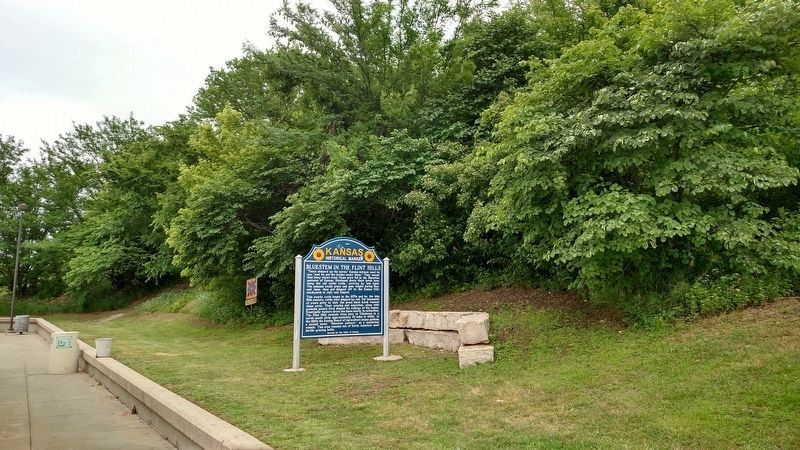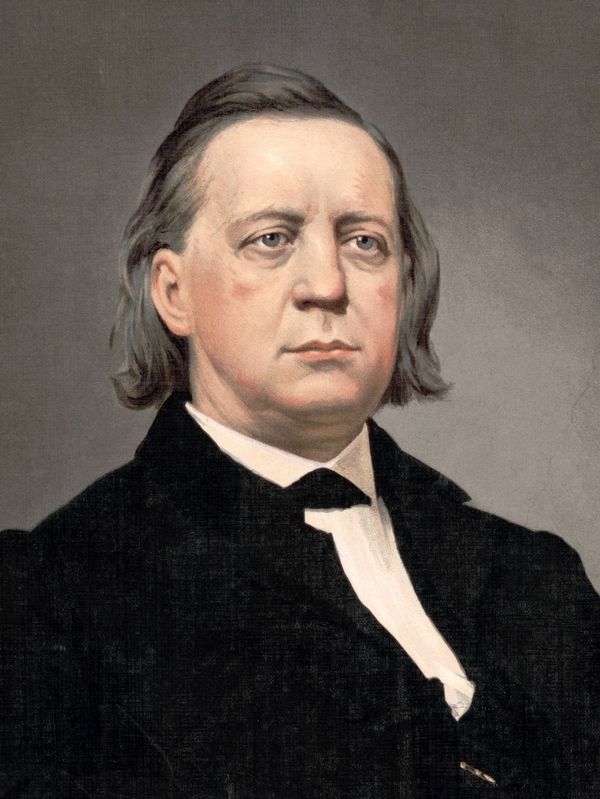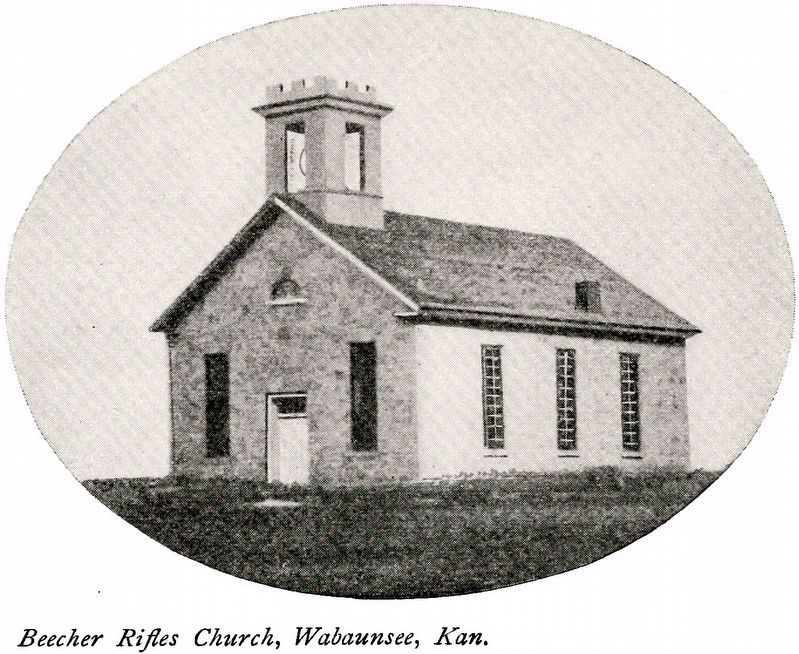Near Paxico in Wabaunsee County, Kansas — The American Midwest (Upper Plains)
Bluestem in the Flint Hills / Beecher Bibles
[Side A]
Bluestem in the Flint Hills
"Texas shipped up the horns,” Kansas cowmen used to say, “and we put the bodies under them.” They meant that bony steers from Texas grew fat in the Bluestem pastures of Kansas. Stockmen drove their herds here along the old cattle trails, arriving by late April. The animals would graze and gain weight during May and June, then get shipped off to the Kansas City stockyards in July and August.
This yearly cycle began in the 1870s and by the late 19th century, cattle were shipped by rail. For thousands of years prior to that, the great bison herds roamed these acres. Their grazing and migration, along with periodic prairie fires shaped the ecology of the region. Eventually hunters drove the bison nearly to extinction. The Flint Hills extends from here to Oklahoma in a north-south strip approximately 60 miles in width. In the 1920s the Kansas Board of Agriculture began pushing a second name, “Bluestem pasture,” as a marketing vehicle. This area remains one of North America’s most fertile grazing belts.
[Side B]
Beecher Bibles
In 1856 free-state colonists from Connecticut joined with earlier settlers to found the town of Wabaunsee, 15 miles northwest of here. Brooklyn abolitionist and clergyman Henry Ward Beecher helped raise funds to supply the settlers with the new Sharps repeating rifle for their defense during the sometimes-violent era of “Bleeding Kansas.” According to an 1856 New York Tribune article, Beecher “believed that the Sharps rifle was a truly moral agency, and that there was more moral power in one of those instruments, so far as the slaveholders of Kansas were concerned, than in a hundred Bibles.” Beecher's congregation also supplied the colonists with Bibles, perhaps leading to the widespread use of the term “Beecher Bibles” to describe the rifles. Wabaunsee residents soon became involved in the Underground Railroad, helping enslaved people to freedom in Canada. Between 1860 and 1862 the community completed the Beecher Bible and Rifle Church, now listed in the National Register of Historic Places. The nearby Mount Mitchell Heritage Prairie today interprets the history of this community.
Erected 2012 by the State of Kansas. (Marker Number 97.)
Topics and series. This historical marker is listed in these topic lists: Animals • Environment • Government & Politics • Industry & Commerce. In addition, it is included in the Kansas Historical Society series list. A significant historical year for this entry is 1856.
Location. 39° 3.609′ N, 96° 7.263′ W. Marker is near Paxico, Kansas, in Wabaunsee County. Marker is at the westbound I-70 rest stop at about mile marker 337, about two miles east of Paxico. Touch for map. Marker is in this post office area: Paxico KS 66526, United States of America. Touch for directions.
Other nearby markers. At least 8 other markers are within 10 miles of this marker, measured as the crow flies. Historical Kansas (about 400 feet away, measured in a direct line); Veterans Memorial (approx. 9.1 miles away); St. Marys (approx. 9.6 miles away); The Great Military Road (approx. 9.6 miles away); Soldiers and Sailors Memorial (American Legion Post) (approx. 9.6 miles away); Brandt Hotel (approx. 9.6 miles away); Site of the Oregon Trail (approx. 9.6 miles away); Limerick Building (approx. 9.6 miles away).
More about this marker. This marker replaced old Kansas Historical Marker #97 "Historical Kansas" in 2012.
Also see . . .
1. Flint Hills Discovery Center. (Submitted on April 20, 2014, by William Fischer, Jr. of Scranton, Pennsylvania.)
2. Tallgrass Prairie National Preserve. (Submitted on April 20, 2014, by William Fischer, Jr. of Scranton, Pennsylvania.)
3. Beecher Bibles. (Submitted on April 20, 2014, by William Fischer, Jr. of Scranton, Pennsylvania.)
4. Bleeding Kansas. (Submitted on April 20, 2014, by William Fischer, Jr. of Scranton, Pennsylvania.)
Credits. This page was last revised on November 30, 2020. It was originally submitted on April 20, 2014, by William Fischer, Jr. of Scranton, Pennsylvania. This page has been viewed 728 times since then and 23 times this year. Photos: 1, 2, 3. submitted on April 20, 2014, by William Fischer, Jr. of Scranton, Pennsylvania. 4. submitted on June 22, 2018, by Mike Wintermantel of Pittsburgh, Pennsylvania. 5, 6. submitted on November 30, 2020, by Allen C. Browne of Silver Spring, Maryland.
